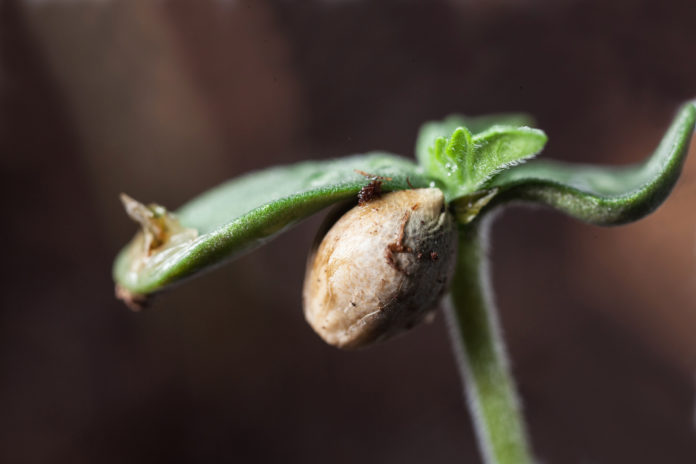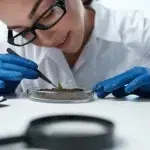In a clone’s or seedling’s first weeks, it is imperative to create specific conditions for a healthy, productive life. Since we are cultivating this crop for its flower and flower compounds, the last three to four weeks of flowering are crucial times for flower formation and ripening.
Start off on the right foot
As a cutting is propagated asexually, its hormonal controls must be switched from branching to rooting. The best rooting techniques employ rooting cubes or cloning machines.
Before roots appear, hormonal gel containing indole-butyric acid (IBA) should be applied as a dip. Rooting cubes should be soaked daily with water and a root accelerator. Each day excess water from the soak must be poured off to inhibit molds and pathogenic fungi. Once roots appear, a cold-pressed kelp extract or quarter-strength A&B base nutrient may be added, as the clone needs basic nutrition at this point. The same mixes may be used in cloning machines, but the solutions must be changed every five to seven days and oxygen added to the system. The machine should be thoroughly cleaned with each change. Seedlings require the same care.
After the plant establishes a healthy root system, the transplant solution should consist of the same mix of root accelerator and base nutrients. A few days after adjusting to its new container and surroundings, incorporate silica into the plant’s diet and establish a full nutrient regimen. Silica enhances the structural integrity of plants. It is stored in the epidermal cell walls in stalks, stems, leaves, and roots. I recommend Amino Treatment as the source of silica, as it contains the organic form mono-silicic acid that is easily recognized and absorbed by plants.
Finish strong…and prosper
Growing buds that are sticky, stanky, and weighty is the goal. The application of chelated iron in weeks five through six will trigger the plant’s production of ethylene, a natural hormone that triggers the ripening phase, kicking into gear the production of all those biomolecules that give plants the properties we love so much.
The last three to four weeks of flowering requires the application of large quantities of phosphorus and potassium (P and K). Phosphorus is necessary for production of ATP, DNA, and other biomolecules. ATP is the energy currency molecule, and the plant needs a ton of it to produce flowers, trichomes, cannabinoids, and resins.
With the bulk of the plant’s mass being accumulated in the final few weeks of its life cycle, cannabis also requires large amounts of phosphorus as a central component of cell membranes for every new cell produced in flowering. Potassium balances the acidity of phosphorus compounds, to keep in place osmotic balance and regulate the opening and closing of stomata (leaf pores). Choose a P-K booster that is clean, stable, and easy to flush.
To produce the maximum terpenes, trichomes, and resins, a diet strategy should include some of the precursors required in the manufacture of these biomolecules. Enzymes transfer sugars from the leaves to the fruit sets. Why leave behind valuable sugars in the foliage when they could be utilized in the buds, where they can be transferred and used up without spending energy to manufacture new molecules? Combining the power of organic additives and clean mineral P-K will produce the quality and quantity the connoisseur market demands.
Andrew Schell has a degree in biochemistry and twenty years of technical gardening experience. His scientific background gives him a unique perspective on plant life and botanical microcosms. He has worked for House & Garden Nutrients and Humboldt Wholesale for the past ten years. House-Garden.us










